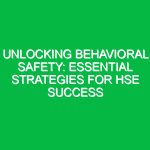Introduction
Breathing in dust is a common occurrence in various environments, from construction sites and factories to agricultural fields. While often overlooked, inhaling dust particles can have significant health implications, making it a critical concern within the Health, Safety, and Environment (HSE) domain. Dust can consist of a variety of materials, including silica, wood particles, and metal shavings, each carrying its own set of health risks. Understanding these risks and implementing protective measures is essential for maintaining a safe and healthy workplace.
In this article, we will explore the importance of addressing the issue of breathing in dust, the potential health risks associated with it, and effective strategies for protection. We’ll also delve into relevant Regulations that guide practices in this area, ensuring that both employers and employees understand their roles in safeguarding health and Safety.
The Composition and Risks of Dust
Understanding the composition of dust is crucial in assessing its risks. Dust can be classified into several categories based on its origin and size:
- Inorganic Dust: This includes materials like silica, asbestos, and metal particles. Inhalation can lead to serious respiratory diseases.
- Organic Dust: Composed of biological materials such as mold spores, pollen, or animal dander, organic dust can trigger allergic reactions and respiratory issues.
- Respirable Dust: Particles that are small enough (typically less than 10 micrometers in diameter) to be inhaled into the lungs, posing a greater risk to health.
Each type of dust poses unique risks. For example, inhaling silica dust can lead to silicosis, a chronic lung disease. Similarly, asbestos dust exposure has been linked to lung cancer and mesothelioma. Understanding these risks emphasizes the need for robust health and Safety Measures.
Health Implications of Breathing in Dust
The health Effects of breathing in dust can vary significantly based on the type of dust and the duration of exposure. Here are some common health implications:
- Respiratory Diseases: Chronic exposure to dust can lead to conditions such as asthma, bronchitis, and chronic obstructive pulmonary disease (COPD).
- Cardiovascular Issues: Studies have shown a correlation between dust exposure and cardiovascular diseases, particularly in individuals with pre-existing conditions.
- Cancer: Certain types of dust, such as asbestos and crystalline silica, are known carcinogens.
In many cases, symptoms may not appear immediately. For instance, a construction worker may not notice any issues for years after prolonged exposure to silica dust. This delayed response can make it challenging to connect health problems to dust exposure, underlining the importance of preventive measures.
Protective Measures Against Dust Exposure
To mitigate the risks associated with breathing in dust, several protective measures can be implemented. Understanding these strategies is crucial for both employers and employees.
1. Personal Protective Equipment (PPE)
Using appropriate PPE is vital to protect against dust inhalation. This includes:
- Respirators: High-efficiency particulate air (HEPA) filters can capture fine dust particles. Ensure that the respirator fits properly and is suitable for the specific type of dust encountered.
- Protective Clothing: Wearing long sleeves and pants can help minimize skin exposure to dust.
- Eye Protection: Safety Goggles can protect the eyes from dust particles that could cause irritation or injury.
2. Engineering Controls
Implementing engineering controls can significantly reduce dust levels in the workplace:
- Ventilation: Proper ventilation systems can help dilute and remove airborne dust. This may include local exhaust ventilation or general dilution ventilation.
- Dust Suppression: Using water sprays or dust suppressants can minimize dust generation during activities such as cutting or grinding.
- Enclosures: Isolating dust-generating processes from workers can reduce exposure.
3. Administrative Controls
Administrative controls involve changing work practices to reduce exposure:
- Training: Educating employees about the risks of dust exposure and how to use protective equipment effectively is essential.
- Work Rotation: Rotating workers through different tasks can minimize individual exposure time to dust.
- Regular Monitoring: Conducting air quality assessments can help identify dust levels and ensure they remain within acceptable limits.
Regulations and Standards
Several regulations govern the management of dust exposure in the workplace. Understanding these legal requirements is crucial for compliance and Safety:
- Occupational Safety and Health Administration (OSHA): osha sets permissible exposure limits (PELs) for various types of dust, including silica. Employers are required to monitor dust levels and implement Control Measures if limits are exceeded.
- National Institute for Occupational Safety and Health (NIOSH): NIOSH provides recommendations and guidelines for minimizing dust exposure, including recommended exposure limits (RELs) that are often more stringent than OSHA’s PELs.
- Environmental Protection Agency (EPA): The EPA regulates air quality and can impose restrictions on dust emissions from industrial processes, ensuring that environmental standards are met.
Complying with these regulations not only protects workers but also helps organizations avoid potential fines and legal liabilities.
Real-Life Examples and Case Studies
Understanding the importance of protective measures against dust exposure can be illustrated through real-life examples. Consider a construction site where workers were consistently exposed to silica dust during demolition activities. Despite initial Training on dust exposure, management failed to enforce the use of respirators. Over time, several workers developed respiratory issues, leading to costly medical claims and a significant decline in productivity.
Conversely, a manufacturing facility that implemented comprehensive dust Control Measures—such as improved ventilation, regular monitoring, and mandatory PPE—saw a drastic reduction in respiratory complaints. Employees reported feeling safer and more productive, illustrating the Benefits of prioritizing health and safety.
Best Practices for Dust Management
To effectively manage the risks associated with breathing in dust, organizations should adopt Best Practices tailored to their specific environments. Here are some recommended strategies:
- Conduct Risk Assessments: Regularly evaluate the work environment to identify potential dust Hazards and implement appropriate control measures.
- Create a Dust Management Plan: Develop a comprehensive plan that outlines Procedures for monitoring, controlling, and responding to dust exposure.
- Foster a Safety Culture: Encourage open communication about dust exposure and safety practices. Empower employees to voice concerns and suggest improvements.
- Review and Update Policies: Regularly review health and safety policies to ensure compliance with current regulations and Best Practices.
By adopting these best practices, organizations can create a safer environment that prioritizes worker health and safety.
Conclusion
Breathing in dust poses significant health risks that must be addressed within the HSE framework. From respiratory diseases to long-term health implications, the dangers of dust exposure are clear. By implementing protective measures, adhering to regulations, and fostering a culture of safety, organizations can protect their workforce and promote a healthier environment.
Understanding the importance of breathing in dust goes beyond compliance; it is about valuing the health and well-being of every individual. As we move forward, let us prioritize effective dust management and ensure that safety remains at the forefront of our practices. Taking action today can lead to a safer, healthier tomorrow for all.


